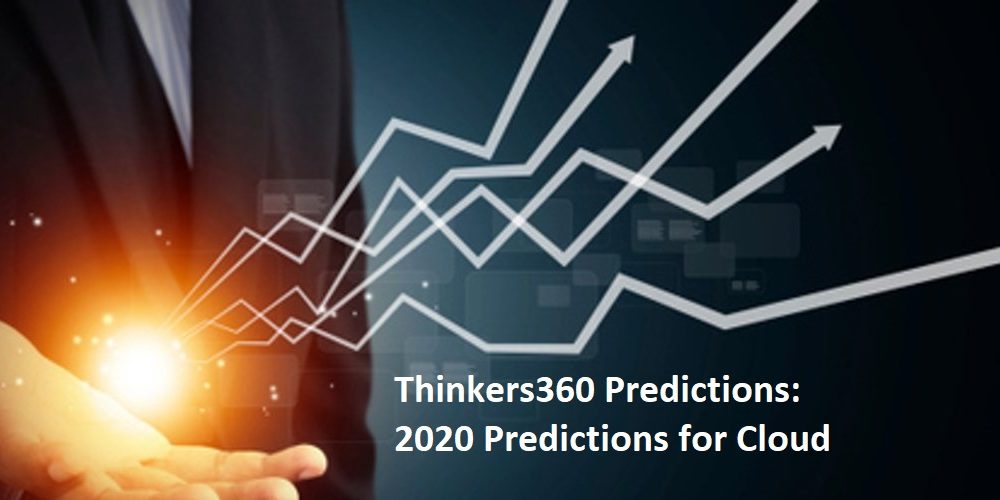Thinkers360 2020 Predictions are member-sourced predictions from our opt-in B2B thought leader and influencer community with 15M+ followers on social media combined. The 2020 Predictions for Cloud Computing are part of a series intended to provide actionable insights for business and technology executives.
Having recently published our Top 20 Global Thought Leaders and Influencers on Cloud Computing, we asked a selection of our Thinkers360 global influencers about their predictions for Cloud Computing in 2020. Here’s what they told us…
What are your predictions for Cloud Computing in 2020?
Connected apps, people, and devices everywhere means that cloud computing will become obsolete as a term in 2020. It’s forecast that 83% of the enterprise workload will be in the cloud next year. No longer a new phenomenon – it just is.
What will we be talking about instead? Artificial Intelligence! As part of cloud computing, with AI, we will leverage these connected apps, people and devices to automate and improve all aspects of business: from omni-channel marketing, sales forecasting, supply chain & operations optimisations to training. Exciting times ahead!
– Astrid van Dorst, MBA | CEO, www.cloudanalysts.com
Containers adoption will accelerate multicloud deployment models. Developers and IT operators will further exploit containers as a mainstay. Escalating benefits from broad container use include ease in choosing best options across different cloud providers for apps and soon data, too. Invest now in getting highly competent at containers use and management.
Private clouds on HCI-based micro data centers will populate the edge. Keep the data and the processing on the edge, closest to the data origins and best use of the resulting analytics. A defacto industry standard will emerge around ease and automation for deploying these private clouds. Look for ease in interoperability between edge clouds and hybrid IT estates.
AIOps-driven insights will make private clouds more cost effective and secure than public clouds, driving down the costs public clouds charge. The smarter the private cloud, the more automated, optimized and efficient. Public clouds will counter that with price reductions that will prompt a price war among the major hyperscale cloud providers. Use your private cloud prowess to extract better deals from the public cloud providers.
Google Cloud will seek a private cloud complement to better compete on hybrid cloud. Via build, buy, and partnerships, Google Cloud will aggressively move to gain a viable presence in enterprises. This will include hardware and automation resources to do hybrid better than AWS and to coot more head-to-head with Microsoft Azure and Azure Stack. Keep an eye on Google Cloud for hybrid cloud services.
– Dana Gardner, Cloud, AI & IT Strategist, Media Producer & IT Trends Influencer
In 2020, the enterprise focus on cloud computing will shift to cloud-native computing. Cloud-native computing brings all the best practices of the cloud (elasticity, scalability, resilience, etc.) to all of hybrid IT. Cloud-native computing also leverages the power of containers and microservices as well as serverless computing and traditional virtualization to support an end-to-end abstraction across all of IT that provides greater security and flexibility than cloud computing can separately.
– Jason Bloomberg, President, Intellyx
The adoption of cloud will continue to grow. Gartner predicts the worldwide public cloud service market will grow from $182.4B in 2018 to $331.2B in 2022. The mix of on-premises, public cloud, and private cloud systems is the most pragmatic approach to cloud adoption because it enables organizations to make the best use of technologies optimized to meet their business objectives. Risks and security are still the most persistent substances for cloud technology. Social tools will bring increased collaboration to the cloud.
– Helen Yu, Founder & CEO, Tigon Advisory Corp.
Importance of Channels. As customers have more choices among cloud vendors, more expertise will be needed to needed to guide their choices. Channels can become experts at cloud-based implementations. As much as some of the hyperscalers would like to cut out the middlemen and deal directly with the customer, increasingly the need for multi-cloud strategies will empower the channel partners. The channel grew up selling and managing “boxes” from Dell, Cisco, HP, and many others. In the future, they will make their money by selling and managing software and services from Azure, Wasabi, Veeam, and other non-hardware products.
– David Friend, CEO, Wasabi (Editor’s Note: For all predictions, see Part I and Part 2)
Cloud computing will continue to grow despite the frequency of breaches due to a lack of administrative controls and unintentional configuration errors. When an administrator had access to an on-premises server, they could only administer that server; a “cloud administrator” can administer all the assets in a given cloud instance, including backing up and exfiltrating entire servers. This is like the unintentional configuration errors that have plagued so many Amazon S3 buckets in 2019, where organizations have stored PII in S3 in a default configuration, and then those data have been accessed by security researchers.
– Kayne McGladrey, Director of Security and IT, Pensar
In 2020, we will see more enterprises embarking the journey to cloud through hybrid and multi-cloud strategy. We will also see an emerging trend of cloud services like RPA as a Service. We are in the midst of fourth industrial revolution where Artificial Intelligence, Machine Learning, and Robotic Process Automation playing a significant role and cloud computing will be the underlying framework for these technologies. Cloud will soon become what Internet is today- a necessity to run businesses!
– Rashim Mogha, Head of Product, AAU Automation Anywhere and eWOW – Founder
Google Cloud will grow through acquisition. Google Cloud is currently number 3 in the marketplace (after Microsoft Azure and Amazon Web Services) and I believe that they will look to land grab through investment in DevOps infrastructure tech that all companies are using.
Amazon will become a key on-premise server vendor. Hybrid cloud is growing in demand and Amazon’s AWS Outposts are their solution to this offering AWS-designed hardware which is fully managed and configurable compute and storage to go in on-premise racks specifically for hybrid cloud.
More cloud compute will be pushed to the Edge. Edge computing in simple terms is the processing and analysis of data workload along a network edge, closer to the consumer, so that data becomes actionable with reduced latency, bandwidth and data overhead for the cloud based datacentre.
– Rob May, Managing Director, ramsac
Enterprises embrace “E = MC2″ as their long-term cloud strategy. Enterprise cloud strategy will involve multi-cloud and hybrid-cloud for reasons of risk mitigation, optionality, legacy application stack and avoiding vendor lock-in.
Edge AI will give rise to new cloud models. A centralized cloud is not the best design pattern for many use cases such as self-driving cars, industrial IoT, immersive experiences using AR/VR which require real-time decisions with almost zero latency. Distributed cloud models are much better suited for such applications.
Data sovereignty issues will influence global cloud infrastructure. In the economic and political realms, we are witnessing the slowdown of globalization and we can expect to see a corresponding shift to data deglobalization. More and more national governments will want data to reside within their jurisdictions and this will influence where new cloud data centers are set up and also have an impact on application architectures. This favors the deep-pocketed vendors such as Amazon, Google and Microsoft who are better placed to invest in new/local infrastructure.
Customers start paying attention to their rising cloud bills. The mainstream enterprise migration to cloud is still underway but early adopter customers are realizing that the cloud costs can add up quite quickly. On the other side of the impressive revenue growth numbers of cloud vendors are the fast-rising costs for customers! Many early adopter customers have initially focused more on the technology and less on the ongoing economics of cloud. Expect that to change in 2020 and the cloud opex will be under greater scrutiny.
Rise to prominence of TechFin experts. It takes a village to raise a child and an assemblage to optimize the cloud. While grappling with cloud security and governance, migration and microservices, enterprises have dropped the ball on cloud cost management. In 2020, companies will not only think about containers but also want to contain costs. Finance experts who understand the various cloud options and technology experts who understand the cost impact of how they build, test, deploy and maintain cloud applications will be in great demand.
– Kashyap Kompella, CEO and Chief Analyst, rpa2ai (RPA to AI) Research
Join us on Thinkers360!
Individuals: Connect and work with global brands as an author, influencer, speaker and more. Showcase your thought leadership profile and portfolio, build your media kit, and participate in our global leaderboards and opportunity marketplace: Sign-Up (free) | Newsletter
Enterprise (including brands & agencies): For brand, influencer, content marketing and speaker bureau services, working with our network of premier opt-in influencers with 15M+ followers on social media: Request an Enterprise Consultation | Explainer Video
Want to discover and work with authors, influencers and speakers (including access to our unique thought leader reports and analytics, personal introductions, and our zero-transaction fee speaker bureau)? Contact us at info@www.thinkers360.com
For custom influencer lists, advertising and leaderboard sponsorship opportunities, please contact info@www.thinkers360.com.
















